Contents
- Introducing Poker Knockout Tournaments!
- IKCM: ICMIZER 2’s new mathematical model for knockout tournaments
- IKCM in action: How a single chip can turn a knockout strategy on its head
- Analyzing custom knockout tournaments in ICMIZER 2
- Frequently Asked Questions about knockout tournaments in ICMIZER 2
Introducing Poker Knockout Tournaments!
As traditional SNG and MTT tournaments wane in popularity, poker rooms are coming up with new tournament formats to keep existing players and attract new ones. One recent novelty are knockout tournaments, which reward you with a cash prize every time you knock an opponent out. This cash prize is taken out of the special knockout prize pool to which each player contributes a share of their buy-in when they register.
The knockout prize is usually not that large, typically around 25% of buy-in. Some tournaments offer higher knockout prizes, like PokerStars’ Super Knockouts where they reach 50% of the total prize fund.
Playing with knockouts drastically changes the tournament strategy that many players have adopted and gotten used to. Going all-in or calling all-ins becomes far more lucrative when you stand to knock someone out in the hand. Considering all the possible knockouts, with lots of short stacks at the table, a middle stack may be forced to play even tighter than usual when pushing, looking for an opportunity to knock out a short stack who’s got nothing to lose.
Classical ICM still works in knockout tournaments, but it’s complicated by having to factor knockouts into equity simulations. This makes it virtually impossible to intuitively find the optimal strategy as you compete for knockout cash prizes.
After PokerStars added many new knockout tournament types, we’ve been swarmed with requests from players all over the world, asking us to support these exciting new tournaments in ICMIZER 2. Players want to design mathematically precise strategies for knockout tournaments and to understand how their opponents’ ranges change based on stack sizes and knockout prize amounts.
You asked and we listened! We’ve developed a special model to support knockout tournaments and have already implemented it in ICMIZER 2. Now when using ICMIZER 2, you are able to analyze knockout tournaments just as you do other kinds. Simply select the appropriate payout structure (or create a custom one, if the default ones do not meet your requirements) and go ahead with hand analysis.
IKCM: ICMIZER 2’s new mathematical model for knockout tournaments
Read this section if you’re an experienced ICM user, or if you want to first see a rigorous verification of how ICMIZER 2 computes knockout tournaments before you believe it works.
The knockout model we developed and dubbed IKCM (Independent Knockout Chip Model) works similarly to ICM. It tells you how translate your chip count into a percentage of the tournament’s knockout prize pool. That is, you can use it to calculate equities for players who are on absolutely equal footing in a knockout tournament.
Suppose you’re down to 4 chips on a table with three other players with stacks of 100, 5 and 5 chips, respectively. Clearly, you have the smallest odds of receiving any knockout prizes here. Even if you go all-in against a 5-chip stack and beat her, you won’t knock her out but only leave her with 1 chip. In the next hand, any player will be able to knock her out. Conversely, had you had 6 chips instead of 4, you would have the potential to knock out up to 2 players and therefore would be vying for a larger share of the knockout prize pool.
While we can come up with several such self-evident statements that hold true for knockout tournaments, it’s difficult to say with certainty how many knockout cash prizes each stack is really vying for. To solve this problem mathematically, we used Monte Carlo methods to simulate the poker game and calculate equities in terms of knockout winnings. Compared to most other formulas, Monte Carlo is very slow, but also extremely accurate in determining how players will knock each other out and thus estimating their true equities.
Unfortunately, Monte Carlo takes noticeable time to analyze even a single stack combination. Considering that a typical 9-player hand requires calculating more than 1,000 stack permutations to arrive at the correct solution, that simulation model is of little practical use for poker players.
So, like the creators of ICM formulas, we’ve developed a special function to approximate as closely as possible the simulated knockout results. This formula had to work fast to allow ICMIZER 2 users to find optimal solutions to just about any tournament situation – including full ring tables where multiple similar calculations have to be run.
Here’s a comparison of the simulation results we obtained by using our IKCM model vs. those based on ultimate-accuracy Monte Carlo methods.
Table 1. Very uneven stack sizes. Payout structure: set reward for each opponent knockout, no extra prizes
Stack size | Chip EV model | Monte Carlo simulations | IKCM knockout model in ICMIZER 2 |
100 | 3.5398 | 2.5866 | 2.5986 |
4 | 0.1416 | 0.4443 | 0.4384 |
4 | 0.1416 | 0.4416 | 0.4384 |
5 | 0.1770 | 0.5275 | 0.5246 |
|
| Total knockouts: 4 | Total knockouts: 4 |
Table 2. Somewhat uneven stack sizes. Payout structure: set reward for each opponent knockout, no extra prizes
Stack size | Chip EV model | Monte Carlo simulations | IKCM knockout model in ICMIZER 2 |
100 | 0.4 | 0.4772 | 0.4669 |
200 | 0.8 | 0.8774 | 0.8735 |
300 | 1.2 | 1.1872 | 1.1942 |
400 | 1.6 | 1.4582 | 1.4653 |
|
| Total knockouts: 4 | Total knockouts: 4 |
Table 3. 1:2:3 stack sizes. Payout structure: set reward for each opponent knockout, no extra prizes
Stack size | Chip EV model | Monte Carlo simulations | IKCM knockout model in ICMIZER 2 |
1000 | 0.5 | 0.5631 | 0.5416 |
2000 | 1 | 1.0276 | 1.0334 |
3000 | 1.5 | 1.4093 | 1.4250 |
|
| Total knockouts: 3 | Total knockouts: 3 |
As you can see from these tables, IKCM numbers are pretty close to those derived in Monte Carlo simulations. For all intents and purposes, our model is very accurate.
As I mentioned earlier, Monte Carlo simulations are just too slow for practical use. Calculating a single stack combination with high accuracy can take seconds, whereas the IKCM model takes only a few milliseconds to do the same.
The Chip EV model, by contrast, is not at all suitable for simulating knockouts. Even in simple scenarios like in Table 3, it gives numbers that are not very close to the accurate ones. When there are many short stacks fighting to knock each other out (Table 1), Сhip EV is off by a factor of 3 or more.
IKCM in action: How a single chip can turn a knockout strategy on its head
It’s intuitively obvious that if you are in a position to knock an opponent out, then you can play looser than conventional ICM dictates. However, intuition is not enough to quantify the impact of this knockout effect on final hand ranges.
Now that we have IKCM available, we can use it to find optimal strategies in knockout tournaments.
One of the most popular knockout tournament formats is 6 max SNG knockouts on PokerStars. Their knockout cash prizes are half of the buy-in, and the regular prize pool is split 50-50 between the winner and the runner-up.
Let’s look at a typical situation in such a tournament: You’re on SB, there’s another similar-size stack behind you, and a large stack on the button. What is your optimal course of action if the large stack on the button gives you a chance to go all-in first?
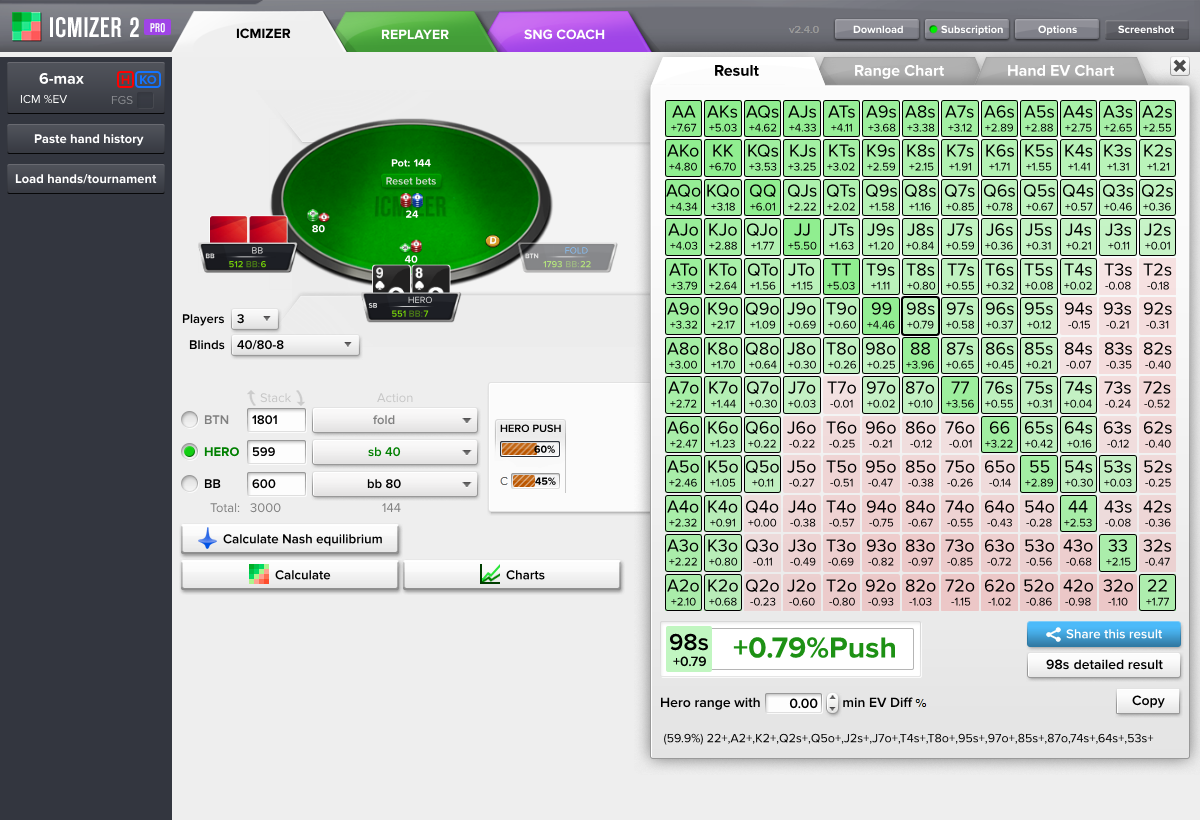
Suppose your stack is just 1 chip smaller than BB’s. You can push 60% of your hands, while he can call with 45% of his. In this case, if you lose the hand, he will get the knockout reward. If you beat him though, the BB will still have 1 chip left and you will have to duke it out with the large stack to knock BB out in the next hand(s).
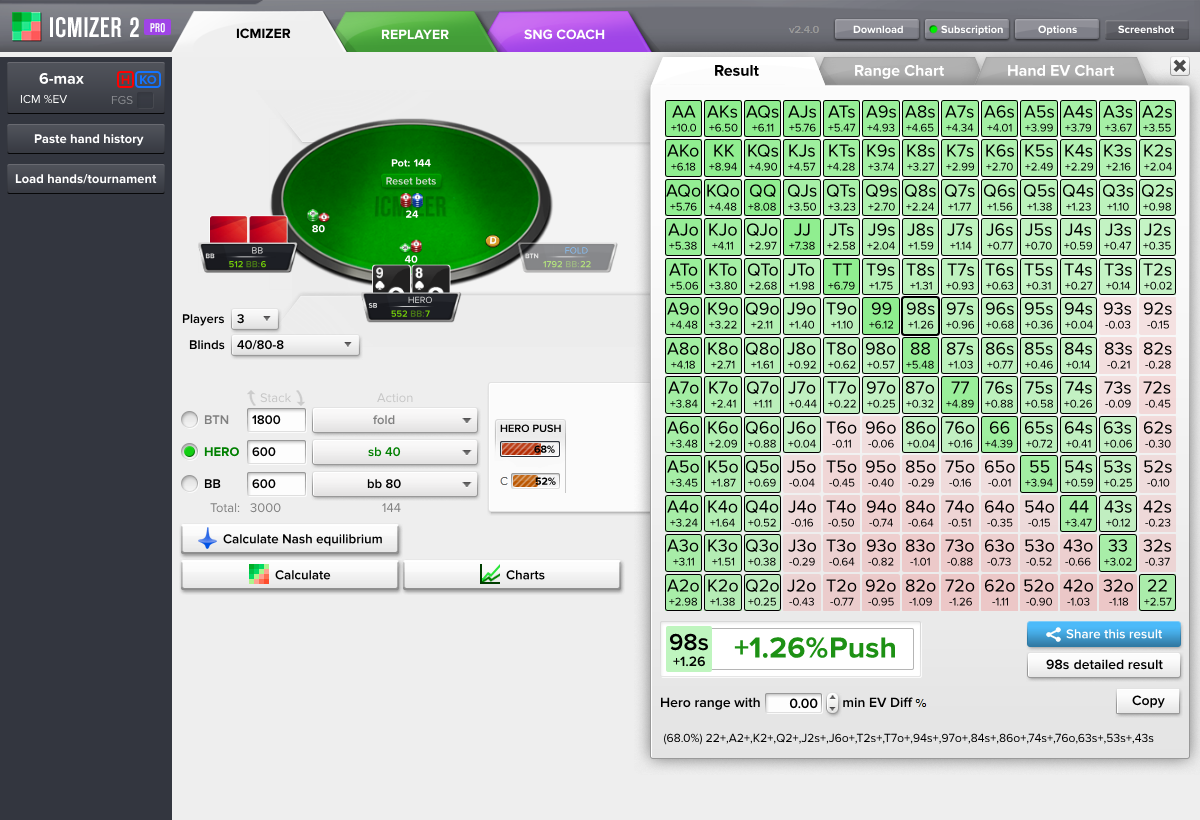
Now, let’s change the stack sizes so ours is equal to BB’s. Your optimal push range goes up to 68%, while BB can call with 52% of his hands. In this setup, you’re in a position to knock BB out, and so is he. This means that the potential knockout rewards have much less impact on our strategy.
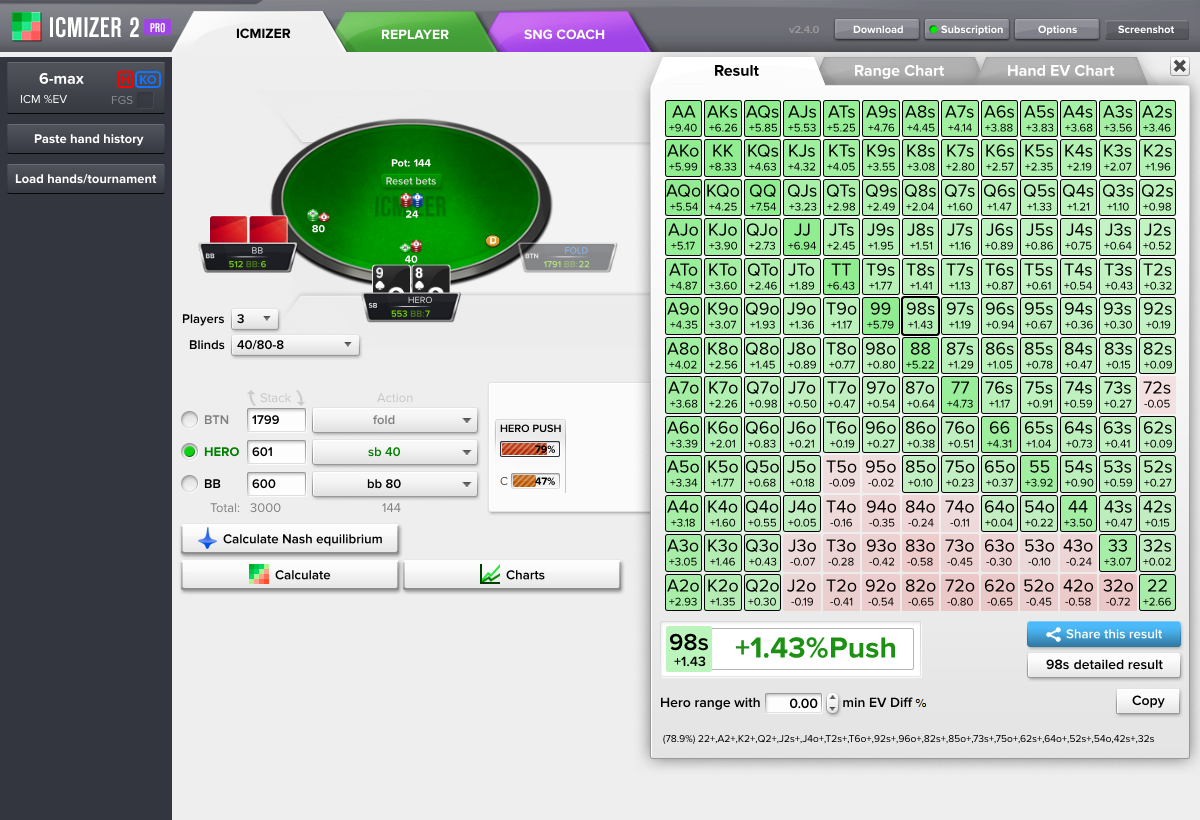
And last but not least, suppose your stack is 1 chip over your opponent’s. This time we may be able to immediately knock him out, but he cannot do the same to us. This widens our push range a lot (to 79%), while his call range shrinks.
This goes to show that even tiny changes in table positions and stack sizes have (or should have) a big impact on your knockout strategy. That’s what makes knockout tournaments difficult to play optimally. While it’s clear that you should expand your call range whenever there are opponents to knock out, this gut feeling does not tell you exactly by how much. The good thing is that now our calculator can solve this problem for you!
Analyzing custom knockout tournaments in ICMIZER 2
Out of the box, ICMIZER 2 understands PokerStars’ most popular SNG knockout tournament formats. But it also offers a way for you to analyze any hands from any knockout tournaments, like МТТs from any other poker room you prefer.
To analyze hands in non-default tournaments, create a new tournament and specify the following: regular payouts for paid places, knockout rewards, and the number of players at tournament start.
Open the tournament selection screen and click the Create New button:
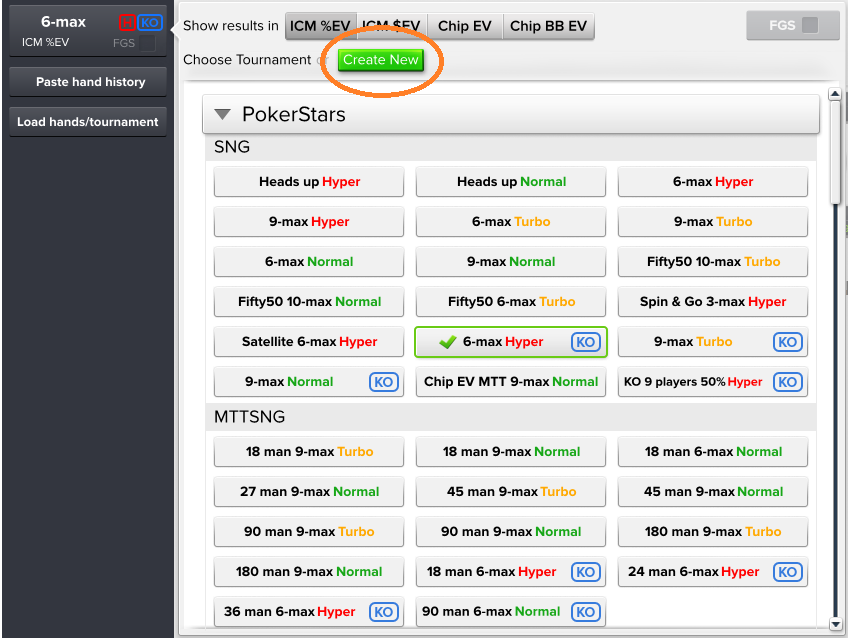
In the next dialog window, select the Knockout check-box and complete the other fields.
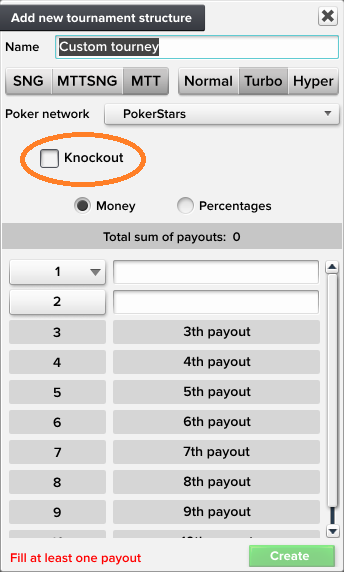
After payout and knockout rewards are provided, save your new tournament by clicking the green Create button in the bottom right-hand corner.
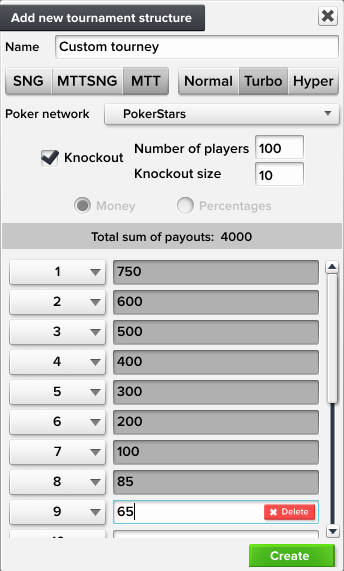
The tournament you just created will be automatically selected so you can start analyzing hands. Oh, and the blinds in the new tournament will be empty at first, so once you enter those as well, you’re good to go.
Frequently Asked Questions about knockout tournaments in ICMIZER 2
Q: Does FGS work with knockout tournaments?
А: Yes, Future Game Simulations model is available for KO tournaments.
Q: Can I analyze Super Knockout tournaments from PokerStars?
А: Yes, those are not essentially different from other knockout tournaments, except for bigger knockout cash prizes.
Q: Can I analyze Progressive Knockout tournaments from PokerStars?
А: Yes! Learn more in our article about Progressive Knockout strategy.
Q: Why does ICMIZER give calculation results for knockout tournaments that are different from other poker calculators or trackers?
А: IKCM is our proprietary mathematical model and only available in ICMIZER 2. Other poker calculators don’t use it, so they may provide different results.
Q: Does IKCM work in МТТ tournaments before the final table of a knockout tournament?
А: Currently it doesn't.
Q: Are knockout tournaments available for training with SNG Coach?
А: Yes, SNG Coach offers the common SNG and MTTSNG knockout tournaments from PokerStars. If you would like to see other knockout tournaments from other poker rooms supported, let us know!
Many exciting updates are coming. Stay tuned to learn more about new features of ICMIZER 2!